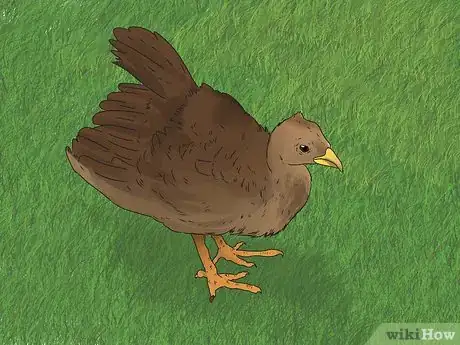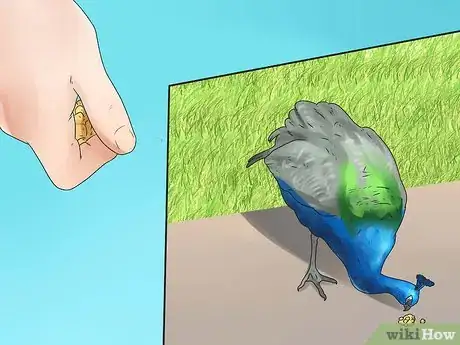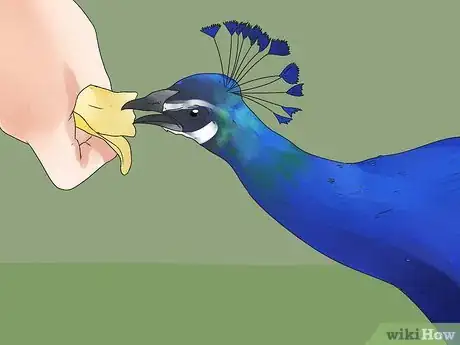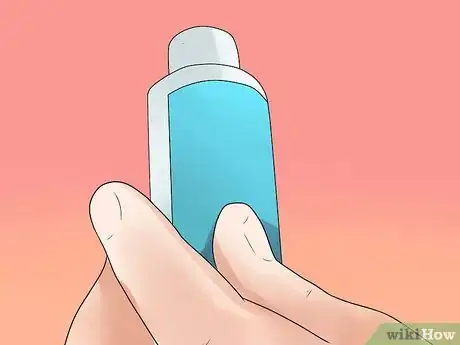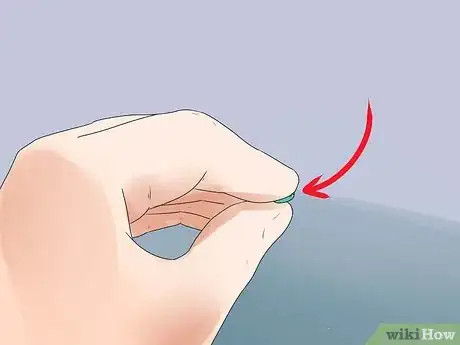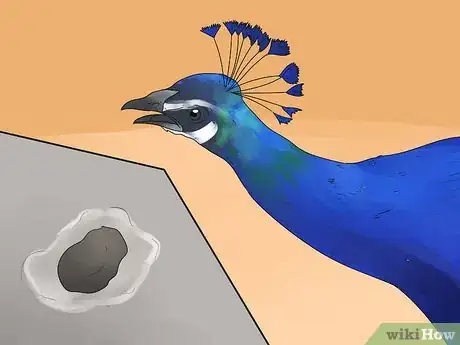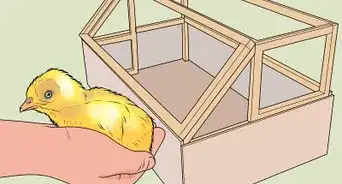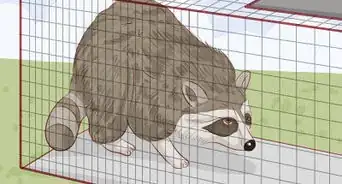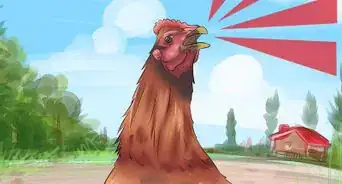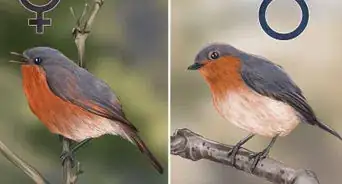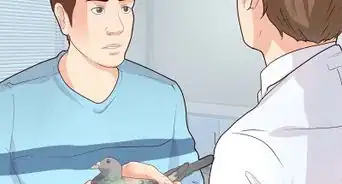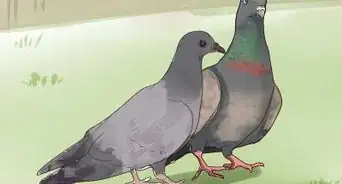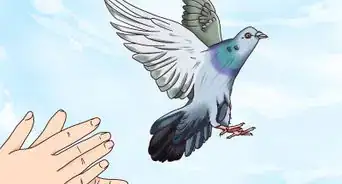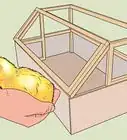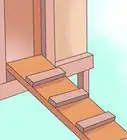wikiHow is a “wiki,” similar to Wikipedia, which means that many of our articles are co-written by multiple authors. To create this article, 32 people, some anonymous, worked to edit and improve it over time.
There are 8 references cited in this article, which can be found at the bottom of the page.
wikiHow marks an article as reader-approved once it receives enough positive feedback. This article received 29 testimonials and 94% of readers who voted found it helpful, earning it our reader-approved status.
This article has been viewed 459,346 times.
Learn more...
Peacocks are spectacular and delightful pets, most suitable for farms and rural surroundings. They are always a sight to behold when the males begin to strut around with their tail feathers extended! Males are commonly referred to as 'peacocks,' while females are commonly referred to as 'peahens.' Many people simple call both sexes 'peacocks' or 'peafowl.'
Steps
Housing
-
1Keep chicks warm. Keep chicks in a heated area for the first 4 to 6 weeks of their lives.[1] It's generally a good idea to start out with a temperature of about 95˚F and decrease the temperature by about 5˚/week. However, this can vary greatly depending on the time of year and your geographic location.
- Keep an eye on your chick's body language to recognize the best temperature. When chicks are cold, they will huddle together. When they're hot, they'll try to get as far away from the heat source as possible. The best temperature will be when the chicks can move freely without exhibiting either of these behaviors.
-
2Build a large pen.[2] This is necessary if you want to keep your peacock from flying away. It should be at least 8 feet (2.4 m) tall, or taller, to ensure that your peacocks are able to fly and/or fan their tails freely. Chicken wire is fine for both the walls and the roof. The roof should also arch or come to a point in places where it will be higher than the rest.
- Make sure that, if you are getting a male, the pen is wide and long enough for him to display his feathers fully when he struts. Not doing so will result in broken feathers or other injuries.
Advertisement -
3Provide a wooden shelter similar to a small shed or barn.[3] Make it inside or connected to the main coup for your birds to roost and/or nest in. You may want to put a warming light in this area and bed it with straw. Provide lofts for the peacocks to stand on and regular perches. Be sure to check the entire pen for places where raccoons, foxes, or other small pests can get in.
- If you have a pest problem, consider placing a radio near the peacock's pen. Keep it on at all times. Predators and pests are less likely to make themselves known if they hear human voices.
-
4Do not let your peacocks roam free. Although peacocks raised from chicks will rarely stray far from where hatched, they do have a tendency to turn semi-wild if left to their own devices. Be sure to keep them in an enclosed area if you have strict property lines or are afraid of losing your peafowl.
-
5Never overcrowd your peacocks. Not only does this lead to an uncomfortable and unhappy life for your peafowl, but it can cause severe disease outbreaks, making it a poor economic decision for you. You should have about 80 square feet of space per bird.[4]
Feeding
-
1Provide food and water dishes. Using hanging food dishes (hanging from the ceiling by chains) tends to keep mice from getting into the food. Keep the water elevated or protected in some way as well so that you do not get droppings in it. Alternatively, use a 3 or 4 gallon (11.4 or 15.1 L) bucket for water.
-
2Feed the chicks. Peacock chicks should get a high protein diet for their first 3 months of life. Look for a Game Bird feed crumble of about 25 to 30% protein.[5] As they get older, begin to wean them off the crumble; too much protein in a grown peacock can cause serious leg deformities.
-
3Begin to wean your chicks from the crumble. After three months, the chicks should be weaned to either Game bird feed or Game bird pellets (Note that pellets are best for birds in cages with wire bottoms). This can generally be done using a 6 week transition schedule, but you should pay close attention to the response of your chicks. If they stop eating the feed, continue feeding them what they will eat and try again another day. The six week program is as follows:[6]
- Week 1: 3 parts crumble to 1 part adult food.
- Week 2: 2.5 parts crumble to 1 part adult food
- Week 3: 2 parts crumble to 1 part adult food
- Week 4:1.5 parts crumble to 1 part adult food
- Week 5:1 part crumble to 1 part adult food
- Week 6: .5 part crumble to 1 part adult food
- Week 7: All adult food.
-
4Give your peacocks occasional treats. While too many treats can cause health problems, giving your peacocks a little something special now and then can be helpful in keeping them from straying or to help them swallow medicine. To treat your peacock, consider giving him fruits, vegetables, bread, unsweetened cereals, dog food, or cat food.[7] Do not give them small bones, as they may choke.
Health
-
1Keep the peacocks healthy. Health checks are very good (with testing as appropriate), when you acquire your new peacock, and each year thereafter, to check for and prevent common illnesses.
-
2De-worm your peacocks. Caged peacocks should be wormed at least every other month (more often if needed). Free range peacocks should be wormed at least once every three months. There are a variety of products that can be used for worming. However, most of them are intended for dogs, cats, chickens, turkeys, or cows. Here are some that you can also use for your peacocks:[8]
- Piperazine. This is a general wormer that comes in liquid or pill. The liquid can be put in the water and used to de-worm a bunch of younger birds at once. The pill must be force fed to the peacock.
- IVOMEC. IVOMEC is another very effective, general use wormer. However, it is not effective against capillaria worms. If you choose to use IVOMEC, it is recommended that you alternate between IVOMEC and Panacur (Panacur is especially effective against capillaria worms). Note that these two should never be given at the same time. Alternate which one you use each time you de-worm.
- Ivermectin Cattle wormer. This is commonly used to worm breeding stock. It can be hidden in a treat and given to the peacock or force fed.
-
3Keep an eye out for external parasites. In addition to worms and internal parasites, external parasites such as lice can cause problems with your flock.[9]
- Lice. These insects live their entire lives on the host, feeding on skin, scales, and feather debris. If lice are found on your birds, all birds in your flock should be treated with a safe pesticide.
- Mites. These bugs are more resistant to pesticides than lice. If you find mites, you must treat your birds every 10 days for 4 to 5 weeks. Then, it is recommended to treat your flock monthly until you are sure the mites have disappeared.
- Chiggers. Chiggers feed on thighs, breasts, wings, and the vent, resulting in red scabby patches on your birds. To treat, you must treat the entire pen/area inhabited by the bird.
-
4Watch for protozoan diseases. Protozoa are single-celled organisms that can cause infection and other illness in a variety of animals. Some important ones to watch out for with your peacocks are:[10]
- Coccidiosis. This is generally just found in birds 3 to 12 weeks old. It is not contagious. The most prominent symptom is black, watery stool. To mitigate, treat with a coccidiostat or a sulfa drug added to the feed. It is a good idea to add preventative medication to your peafowls' food while they are of a susceptible age.
- Histomoniasis. Chicks between 5 and 14 weeks old are most likely be affected by this. Symptoms include watery yellowish stools, drowsiness, and weakness. It is contagious. To treat, use Metronidazole or copper sulfate to treat.
- Leucocytozoonosis. This protozoan attacks the white blood cells of the bird. Symptoms include severe anemia, fever, weakness, loss of appetite, and difficulty walking. It is generally transmitted by black flies and biting midges, which both breed in fast-flowing streams. It is recommended to keep your birds indoors during the active season of these insects. If you do have a problem, treatment will call for a sulfa drug or clopidol.
- Pigeon Malaria. Here, it is the red blood cells of the bird that are attacked. Symptoms include weakness, loss of appetite, and eventually death. Like Leucocytozoonosis, Pigeon Malaria is transmitted by biting midges. To prevent this disease, be sure to keep insect levels under control and give your birds a low level of antimalarial medication of Clopidol if you are worried about them getting affected.
Community Q&A
-
QuestionWe have a lone male peacock. Would a peahen stop him from calling during the breeding season?
 Community AnswerNo. Peacocks will always call during the few months of the breeding season. Getting a female will give him company and give you the possibility of more peacocks.
Community AnswerNo. Peacocks will always call during the few months of the breeding season. Getting a female will give him company and give you the possibility of more peacocks. -
QuestionWhat kind of grain should I feed peacocks?
 Community AnswerChicken pellets and mixed grains (barley, wheat, rice) are good. Corn feed is also acceptable. You might also want to add some dog food into the mix.
Community AnswerChicken pellets and mixed grains (barley, wheat, rice) are good. Corn feed is also acceptable. You might also want to add some dog food into the mix. -
QuestionWill the peacock harm the chicks once they are hatched?
 Community AnswerYes, the males are known to be quite aggressive, oftentimes plucking the feathers since they deem the newcomer a threat. This is why it's always best to house males and females separately.
Community AnswerYes, the males are known to be quite aggressive, oftentimes plucking the feathers since they deem the newcomer a threat. This is why it's always best to house males and females separately.
Warnings
- Do not keep two male peacocks in the same coop. They can and will fight with one another, and death is the common outcome of these fights.⧼thumbs_response⧽
- Avoid access to metallic objects such as coins, toys, nails, solder or loose wire.⧼thumbs_response⧽
- Avoid feeding chocolate, coffee or alcohol to your peacocks as these can be toxic.⧼thumbs_response⧽
- Although peacocks can be kept with common chickens, blackhead, caused by a germ that is transmitted with roundworms, is common in peacocks kept with them. It is preferable to house the two species separately.⧼thumbs_response⧽
- Since they rarely have their wings clipped, you may want to keep your peacock in a large coop.⧼thumbs_response⧽
- Peacocks' loud calls are a problem if kept in urban areas.⧼thumbs_response⧽
- Peahens are prone to fox attacks, especially if looking after chicks. The males are better able to defend themselves and will readily fly into trees, hence there is often an excess of male peacocks compared with peahens.⧼thumbs_response⧽
Things You'll Need
- Chicken wire
- Wood
- Nails
- Chicken pellets/seed
- Dog food
- Fruits/Vegetables
- Straw/Hay/Or any other similar bedding
- Elevated food/water dishes
References
- ↑ https://unitedpeafowlassociation.org/articles/keeping-peafowl-dos-donts/
- ↑ https://animals.mom.me/how-to-build-pens-for-peacocks-8459424.html
- ↑ https://www.wideopenpets.com/5-essential-tips-for-keeping-peacocks-as-pets/
- ↑ https://animals.mom.me/how-to-care-for-peacocks-8447134.html
- ↑ http://aboutpeafowl.com/feeding-peacocks-and-peahens-peafowl-food-how-to-feed-peafowl-to-keep-the-birds-healthy/
- ↑ http://www.bowspeafowlfarm.com/peafowlcare.html
- ↑ https://animals.mom.me/what-kinds-of-foods-are-recommended-to-feed-peacocks-4715944.html
- ↑ https://unitedpeafowlassociation.org/articles/keeping-peafowl-dos-donts/
- ↑ https://unitedpeafowlassociation.org/articles/diseases-of-peafowl/
About This Article
To care for peacocks, keep the chicks in a heated area for the first 4 to 6 weeks of their lives. Build them a pen that’s at least 8 feet tall so the males can fan their tails freely without injuring themselves. You'll also want to add a wooden shelter inside or connected to the main coup for your birds to nest in. Place hanging food and water dishes in the coup, and feed them a high protein diet for the first 3 months of life. As they get older, transition to an adult food since too much protein can lead to deformities. To keep your peacocks healthy, de-worm them every other month. To learn how to keep external parasites off your peacocks, keep reading!



